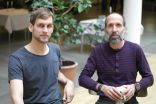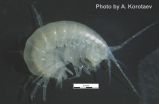(Press-News.org) Practice may not make perfect, but visualization might. New research shows that people who imagined a visual target before having to pick it out of a group of distracting items were faster at finding the target than those who did an actual practice run beforehand. The findings are published in Psychological Science, a journal of the Association for Psychological Science.
"The idea that we can train our brains to work better is all the rage across society, but our research suggests that the human brain may benefit as much, or even more, from imagining performing a task, than the brain does from practicing a task over and over," says psychological scientist and study author Geoffrey Woodman of Vanderbilt University.
"Until now, people have thought that imagining performing a task improved how efficiently people could decide how to respond to objects, or how well those motor responses were executed. To our knowledge, this study is the first demonstration that imagery actually changes how information is processed early on in the visual system," Woodman explains.
Imagery, or visualization, is commonly used as a technique to improve performance in various sports. When Woodman heard an interview with legendary tennis player Billie Jean King -- in which she attributed her success in tournaments to imagining what the ball would look like coming at her under different conditions - he began to wonder whether visualization might actually improve visual processing and not just motor performance.
The research team - including Vanderbilt researchers Robert M.G. Reinhart and Laura J. McClenahan - brought participants to the lab and had them look at a computer screen while their brain activity was recorded via EEG. The participants looked at a series of images, each of which contained a bunch of letter Cs arranged in a ring - importantly, the Cs varied in how they were oriented (i.e., which way the gap in the C pointed). The participants were asked to determine, as quickly and accurately as they could, whether a target - a red or green C with a particular orientation - was present or absent in each image.
During one part of the experiment the participants were asked to imagine looking for the target C before the test trial. During another part of the experiment, participants were given an actual trial to practice on before they did the test trial.
Imagining enabled participants to search more efficiently, speeding up how quickly they were able to find the target. And participants who imagined searching for the target showed bigger improvements in performance that did the participants who actually practiced the visual search.
"We ended up running a fairly large number of experiments because it was so surprising that imagery beat actual practice," says Woodman.
The results of these experiments indicated that imagination is superior to practice because it doesn't involve as much visual interference. When participants practice a search, the distracting stimuli (all the non-target Cs) appear to leave traces in memory that interfere with performance on the next visual search. When participants imagine the search, on the other hand, the non-target stimuli receive much less focus, and are therefore less likely to interfere with later performance.
The increased efficiency brought on by imagination was also supported by the EEG data, which showed a link between imagination and a pattern of brain activity thought to be specialized for shifting visual attention.
"We found that imagining searching for targets changed how strongly the visual system responded to the targets within 200 ms of an array of objects appearing," says Woodman.
The researchers point out that these findings have broad implications across a variety of fields:
"This study indicates that some of the success of imagery for learning in sports, music, and clinical settings is due to how well our sensory systems process inputs. So using imagery can change information processing in the brain at the earliest levels," Woodman concludes.
INFORMATION:
This work was supported by grants from the National Institutes of Health (R01-EY025275, R01-EY019882, P30-EY08126, F31-MH102042, and T32-EY007135) and the National Science Foundation (BCS-0957072).
All materials have been made publicly available via Open Science Framework and can be accessed at https://osf.io/9pe2x/. The complete Open Practices Disclosure for this article can be found at http://pss.sagepub.com/content/by/supplemental-data. This article has received the badge for Open Materials. More information about the Open Practices badges can be found at https://osf.io/tvyxz/wiki/1.%20View%20the%20Badges/ and http://pss.sagepub.com/content/25/1/3.full.
For more information about this study, please contact: Geoffrey F. Woodman at geoffrey.f.woodman@vanderbilt.edu.
The article abstract is available online at http://pss.sagepub.com/content/early/2015/05/11/0956797615577619.abstract
The APS journal Psychological Science is the highest ranked empirical journal in psychology. For a copy of the article "Visualizing Trumps Vision in Training Attention" and access to other Psychological Science research findings, please contact Anna Mikulak at 202-293-9300 or amikulak@psychologicalscience.org.
HANOVER, N.H. - Opening the way for new applications of smart devices, Dartmouth researchers have created the first form of real-time communication that allows screens and cameras to talk to each other without the user knowing it.
Using off-the-shelf smart devices, the new system supports an unobtrusive, flexible and lightweight communication channel between screens (of TVs, laptops, tablets, smartphones and other electronic devices) and cameras. The system, called HiLight, will enable new context-aware applications for smart devices. Such applications include smart glasses ...
Singapore, 18 May 2015 - A seven-year scientific study has revealed that microbial communities in urban waterways has the potential to play an important role in cleansing Singapore's waterways and also act as raw water quality indicators.
The study found that canals designed to channel rainwater host microbial communities that could remove and neutralise organic pollutants in raw water. These organic pollutants are currently at trace levels in raw water - well below the United States-Environmental Protection Agency (US-EPA) drinking water standards - which is removed ...
In a letter to the Medical Journal of Australia published today, a Monash University-led team is asking for hepatitis C virus patients to gain improved access to drugs to prevent liver related deaths.
Hepatitis C virus (HCV) infection is a major public health burden in Australia, with estimates of 230,000 people chronically infected.
The research team are calling for the government to subsidise a new therapy which has high cure rates, known as direct acting antiviral (DAA) therapy.
Monash University Professor William Sievert said a delay in access to DAA treatment ...
Washington, DC (May 18, 2015) -- Patients faced with a choice of surgical options want to engage their physicians and take a more active role in decision-making, according to a study (abstract 567) released at Digestive Disease Week® (DDW) 2015. Further, those physicians must provide better support tools to help patients participate in the decision-making process. The study found that patients consult multiple sources (Internet, family, friends, doctors, etc.) and say that while doctors provide the most believable information, it was also the least helpful.
"In this ...
The historical past is important when we seek to understand environmental conditions as they are today and predict how these might change in the future. This is according to researchers from Umeå University, whose analyses of lake-sediment records show how lake-water carbon concentrations have varied depending on long-term natural dynamics over thousands of years, but also in response to human impacts over the past several hundred years. The study has been published in PNAS (the Proceedings of the National Academy of Sciences).
Environmental monitoring programmes ...
Just as alchemists always dreamed of turning common metal into gold, their 19th century physicist counterparts dreamed of efficiently turning heat into electricity, a field called thermoelectrics. Such scientists had long known that in conducting materials the flow of energy in the form of heat is accompanied by a flow of electrons. What they did not know at the time is that it takes nanometric-scale systems for the flow of charge and heat to reach a level of efficiency that cannot be achieved with larger scale systems. Now, in a paper published in EPJ B Barbara Szukiewicz ...
The grounding of a giant iceberg in Antarctica has provided a unique real-life experiment that has revealed the vulnerability of marine ecosystems to sudden changes in sea-ice cover.
UNSW Australia scientists have found that within just three years of the iceberg becoming stuck in Commonwealth Bay - an event which dramatically increased sea-ice cover in the bay - almost all of the seaweed on the sea floor had decomposed, or become discoloured or bleached due to lack of light.
"Understanding the ecological effect of changes in sea-ice is vital for understanding the future ...
Scientists are attempting to mimic the memory and learning functions of neurons found in the human brain. To do so, they investigated the electronic equivalent of the synapse, the bridge, making it possible for neurons to communicate with each other. Specifically, they rely on an electronic circuit simulating neural networks using memory resistors. Such devices, dubbed memristor, are well-suited to the task because they display a resistance, which depends on their past states, thus producing a kind of electronic memory. Hui Zhao from Beijing University of Posts and Telecommunications, ...
An international team of scientists have discovered a new species of typhlogammarid amphipod in the limestone karstic caves of Chjalta mountain range -- the southern foothills of the Greater Caucasus Range. The study was published in the open access journal Subterranean Biology.
The new amphipod, which belongs to the genus Zenkevitchia, is the second species known from this group. This new addition to the genus is named Zenkevitchia yakovi after the famous Russian biospeleologist Prof Yakov Birstein.
Typhlogammarid amphipods are a group blind and unpigmented endemic ...
Radiotherapy used in cancer treatment is a promising treatment method, albeit rather indiscriminate. Indeed, it affects neighbouring healthy tissues and tumours alike. Researchers have thus been exploring the possibilities of using various radio-sensitizers; these nanoscale entities focus the destructive effects of radiotherapy more specifically on tumour cells. In a study published in EPJ D, physicists have now shown that the production of low-energy electrons by radio-sensitizers made of carbon nanostructures hinges on a key physical mechanism referred to as plasmons ...



